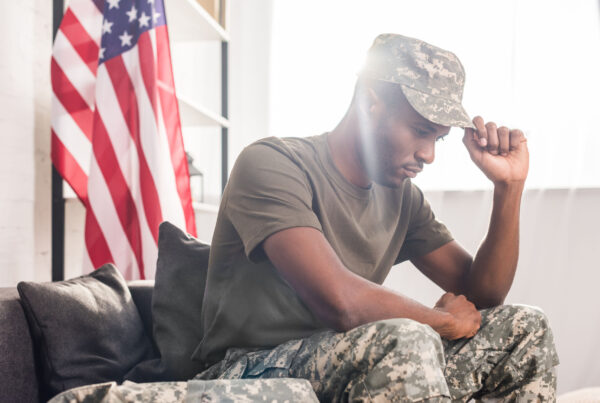”New York, what goals do you have this year? Do any include sleep? Sleep goals can help improve your overall wellbeing. Check out this week's article to learn more!
Reading Time: 10 Minutes
MWi Hacks:
- Learn about setting sleep goals
- Learn about identifying sleep disorders
MWi Summary:
- Sleep goals can be helpful to increase the amount of sleep we get, but it is also important to be evaluated for sleep disorders, especially if you are or were in the military.
- Setting sleep goals can be accomplished through either keeping a sleep diary or using a wearable device to monitor sleep. With sleep diaries, you can track things like how much you slept, how rested you feel, and other lifestyle factors.
- Sleep apnea and insomnia are very common sleep disorders in the military. The high prevalence of sleep apnea is partly attributed to the thicker neck circumference that service members develop from carrying heavy loads. Insomnia is caused by stress, and many military members operate under “high tempo” conditions constantly.
- Five tips for achieving adequate sleep are:
- Be asleep more than two hours before midnight.
- Avoid screen use before bed.
- No sugary foods before bedtime.
- Sleep in the fetal position.
- Keep the room cool for quality sleep.
By now, we all recognize the importance of a quality, restorative night of sleep. Sleep is absolutely critical to perform at our best physically and mentally. Without it, we are required to “catch up” or we continue to suffer. However, even if we know the importance of sleep and line up goals to achieve adequate sleep, it may not always be possible. Sometimes, it is due to family and work constraints. But often times, especially in military personnel, it is due to an underlying sleep disorders that often go untreated. In this blog piece, I cover both and provide some holistic as well as some best clinical practices to ensure that a restless night of sleep is a rarity rather than a common occurrence.
Setting Sleep Goals
We need at least 7 hours of quality sleep a night. The easiest way to achieve at least 7 hours is by setting a sleep goal. Setting sleep goals doesn’t require purchasing a wearable though. Setting sleep goals can be as simple as keeping a sleep diary. The National Sleep Foundation (NSF) has a very comprehensive sleep diary that is free for download (click here). Usually with sleep diaries, you are interested in two facets of sleep: total sleep amount and how rested you feel the next day. Being in tune with both of these can help you tailor your day and lifestyle accordingly so that over time, you are reporting at least 7 hours a night and wake up actually feeling rested. Sleep diaries also allow you to log daily caffeine intake (no energy drinks, please!), exercise intensity, and levels of stress, allowing you to hold yourself accountable for many daily lifestyle practices and healthy habits.
Wearables are also an excellent way to hold yourself accountable for achieving adequate sleep amounts and sleep quality. There are many different flavors of wearables. Some report sleep amounts. Some report sleep quality. Others focus on a general recovery score and daily strain. However, actual, absolute results reported from wearables should be approached with caution. What is more important than the absolute score is the relative score. That is, a consistent track record of “X” number of hours of sleep or “X” number of hours of deep sleep and/or recovery. Consistency is key as consistency means you are in the best position possible for getting adequate and more importantly, restorative sleep.
Identifying Sleep Disorders
Earlier this year, my colleagues and I published a comprehensive review documenting the current state of sleep issues across the military. We entitled it, “Sleep in the United States Military.” The most common of all sleep disorders in military personnel is sleep apnea. Sleep apnea is broadly defined as the inability to breath across a sleep cycle usually resulting in numerous (> 20) awakenings across the night and preventing an individual from entering their most restorative stages of sleep. The consequence is increased daytime sleepiness and fatigue as well as numerous cardiometabolic issues including but not limited to irregular hormone balance, high blood pressure, high blood sugar, and increased visceral (belly) fat. One of many reasons why sleep apnea is thought to be so common in military personnel is due to have a thick neck circumference: an adaptation in response to carrying heavy loads on one’s back and head as a protective mechanism against neck and head trauma. The trade-off of this physical adaptation is that it makes breathing even more difficult at night as muscle is heavy and as a result, places additional strain on the act of breathing.
Another sleep disorder common in military personnel that is often times co-occuring with sleep apnea is insomnia. Insomnia is the inability to “turn off” and fall asleep at night. Like sleep apnea, it results in numerous awakenings across the night and as time goes on, makes the inability to achieve adequate sleep even more challenging. One of the most common causes of insomnia is stress and operating under “high tempo” conditions. If caught early, reducing stress can reduce the likelihood of insomnia but after months of not sleeping, there can be a tipping point of no return and often times, insomnia has to be managed through sleep-promoting medications.
Considering both factors discussed in this blog post, below are some helpful tips for ensuring that you achieve adequate, restorative and avoid some of the common pitfalls that can lead to sleep-apnea and insomnia like states.
1. Be asleep > 2 hours before midnight. Quality sleep is biologically driven by the brain and is often inflexible to environmental change. The best quality sleep is achieved between 2200 – 0600. Quality sleep helps to clear toxins and repair muscle.
2. Electronic devices reduce quality sleep and elevate stress. A recent study found that late-night tweeting increases next-day fatigue and daytime sleepiness. Biologically speaking, blue light emitted from smartphones and TVs stops nighttime release of the hormone that helps us fall asleep: melatonin. There is also something to be said about the psychosocial stress created by social media or checking work emails late at night too.
3. No sugary foods before bedtime. While it is common to wake up starving in the middle of the night, eating low glycemic foods that do not elevate blood sugar (e.g., sweet potatoes over a banana or ice cream) before bedtime will help reduce awakenings in the middle of the night.
4. Sleep in the fetal position. Sleeping on your back or stomach makes the ability to breath difficult during sleep. Use pillows to condition the body to sleep in the fetal position.
5. Keep the room cool for quality sleep. A room temperature between 68 -72 degrees Fahrenheit will help ensure that you do not wake up in the middle of the night and can achieve quality stages of sleep.
MWi would like to thank Allison J. Brager, for her expert insights that we were able to share with our community.
More on the Author:
For more information on holistic health and wellness in military communities, visit social media pages of US Army Warrior Fitness. CPT Allison J. Brager is the Director of Human Performance Operations and Outreach Education for the Army E-Sports and Warrior Fitness teams of the United States Recruiting Command. She is also one of Warrior Fitness athletes. She sits on fatigue management working groups for the Office of the Army Surgeon General, the federal government, and NATO Special Operation Forces. Previously at the Walter Reed Army Institute of Research, she and her teammates leveraged groundbreaking sleep discoveries to deliver knowledge products and materiel solutions to the Army, most recently during Operation Spartan Shield. She is the recipient of two National Research Service Awards from the National Institutes of Health and a former National Academy of Sciences research fellow for research on biomarkers that promote physiological resilience in extreme environments. At present, she is under candidate selection for the Army Astronaut Program in order to do research on the International Space Station. She has an Sc.B. from Brown University and a Ph.D. from Kent State University and is author of the popular science book, “Meathead: Unraveling the Athletic Brain.”






